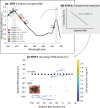Monitoring a changing Arctic: Recent advancements in the study of sea ice microbial communities
- PMID: 34822116
- PMCID: PMC8692635
- DOI: 10.1007/s13280-021-01658-z
Monitoring a changing Arctic: Recent advancements in the study of sea ice microbial communities
Abstract
Sea ice continues to decline across many regions of the Arctic, with remaining ice becoming increasingly younger and more dynamic. These changes alter the habitats of microbial life that live within the sea ice, which support healthy functioning of the marine ecosystem and provision of resources for human-consumption, in addition to influencing biogeochemical cycles (e.g. air-sea CO2 exchange). With the susceptibility of sea ice ecosystems to climate change, there is a pressing need to fill knowledge gaps surrounding sea ice habitats and their microbial communities. Of fundamental importance to this goal is the development of new methodologies that permit effective study of them. Based on outcomes from the DiatomARCTIC project, this paper integrates existing knowledge with case studies to provide insight on how to best document sea ice microbial communities, which contributes to the sustainable use and protection of Arctic marine and coastal ecosystems in a time of environmental change.
Keywords: Algae; Biogeochemistry; Climate Change; Microbes; Modeling; Sea ice.
© 2021. The Author(s).
Figures






References
-
- Aksenov Y, Popova EE, Yool A, Nurser AJG, Williams TD, Bertina L, Bergh J. On the future navigability of Arctic sea routes: High-resolution projections of the Arctic Ocean and sea ice. Marine Policy. 2017;75:300–317. doi: 10.1016/j.marpol.2015.12.027. - DOI
-
- Aumack CF, Juhl AR, Krembs C. Diatom vertical migration within land-fast Arctic sea ice. Journal of Marine Systems. 2014;139:496–504. doi: 10.1016/j.jmarsys.2014.08.013. - DOI
MeSH terms
Grants and funding
LinkOut - more resources
Full Text Sources

